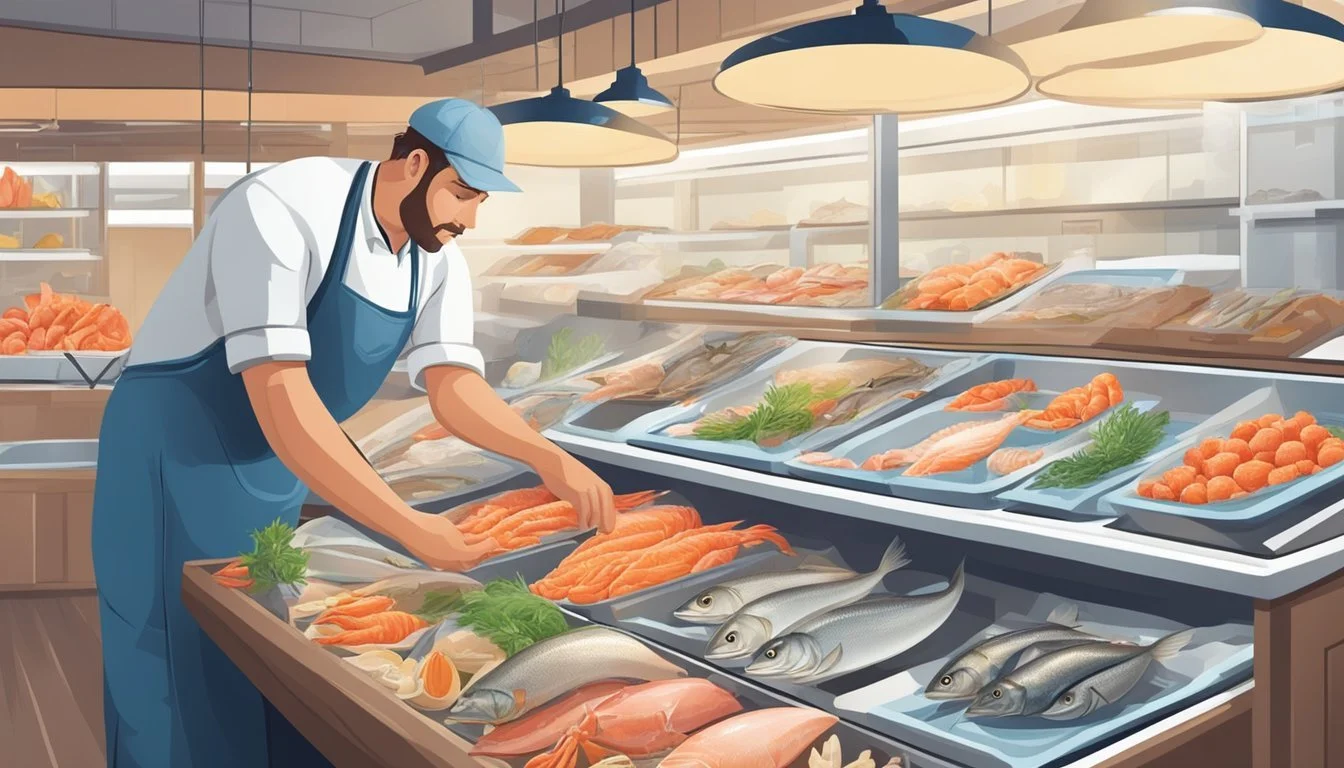Ocean's Bounty: Navigating the Top Grocery Stores for Premium Seafood
When it comes to purchasing fish, choosing the right grocery store can make a significant difference in quality, variety, and sustainability. Some stores excel in offering fresh, high-quality seafood options, while others may fall short.
Whole Foods consistently ranks as one of the top grocery stores for fish, offering a diverse selection of fresh and sustainably sourced seafood. Their commitment to quality extends to both raw cuts and pre-seasoned options, catering to various culinary preferences. Other notable contenders include Wegman's, Safeway, and Trader Joe's, each providing a range of fresh and frozen fish options.
While many stores offer decent seafood selections, it's important to note that not all grocery chains prioritize fish quality equally. Some may have questionable sourcing practices or lower-quality products. Shoppers should consider factors such as certification labels, store reputation, and visual inspection when selecting fish from their local grocery store.
Assessing Seafood Quality
Evaluating seafood quality involves examining key freshness indicators and understanding considerations for frozen fish. Knowing what to look for helps ensure you select the best seafood at the grocery store.
Freshness Indicators
When assessing fresh fish, use your senses. Look for clear, bulging eyes and bright, red gills. The flesh should be firm and spring back when pressed. Fresh fish should have a mild, ocean-like scent - avoid any with a strong, fishy odor.
Check for vibrant colors. Salmon should have a rich pink hue, while tuna steaks should be deep red. Avoid fish with dry, dull skin or discolored patches.
For shellfish like shrimp, look for firm texture and no black spots or yellowing. Live shellfish should close tightly when tapped.
Frozen Fish Considerations
Frozen fish can be high quality if handled properly. Check packaging for ice crystals or freezer burn, which indicate temperature fluctuations.
Look for vacuum-sealed packaging to prevent freezer burn. Avoid packages with visible frost inside.
Fillets should be frozen individually, not in a solid block. This allows for easier thawing of portioned amounts.
When thawing, use cold water or refrigeration. Never thaw at room temperature, which promotes bacterial growth.
Properly frozen fish can maintain quality for several months. Check "best by" dates and avoid old stock.
Varieties of Fish and Shellfish
Grocery stores offer a wide array of fish and shellfish options to suit diverse tastes and cooking preferences. From familiar favorites to exotic catches, the seafood counter provides choices for every palate and occasion.
Common Fish Types
Salmon remains a popular choice, available in Atlantic and Pacific varieties. Wild-caught options are prized for flavor, while farmed salmon offers affordability. Tuna, another staple, comes in various forms - fresh steaks, sashimi-grade, or canned.
Cod and tilapia are versatile white fish suitable for many recipes. Catfish, a freshwater option, is often farm-raised and budget-friendly. For a delicate taste, sole fillets are an excellent pick.
Many stores now emphasize sustainable seafood options. Look for labels from Seafood Watch or Marine Stewardship Council (MSC) certifications to make environmentally conscious choices.
Exotic and Seasonal Selections
Pacific halibut, prized for its firm texture and mild flavor, is often available seasonally. King salmon, known for its rich taste and high omega-3 content, is a premium option during its peak season.
Whole Foods and other specialty grocers may offer less common species like monkfish or barramundi. These stores frequently highlight seasonal catches, providing opportunities to try new varieties.
In the shellfish section, find classics like lobster, mussels, and clams. Oysters and scallops offer gourmet options for special occasions. Many stores now provide pre-shucked oysters for convenience.
Frozen seafood sections expand options further, often including octopus, squid, and unique fish varieties not found fresh.
Sustainability and Environmental Considerations
Grocery stores are increasingly prioritizing sustainable seafood sourcing and environmental stewardship. Certifications and ratings help consumers make informed choices about the fish they purchase.
Sustainable Sourcing Practices
Many grocery chains have implemented responsible seafood sourcing policies. They work directly with suppliers to ensure fish are caught or farmed using methods that don't deplete stocks or harm ecosystems.
Some stores have discontinued selling overfished species or those caught using destructive practices. Others focus on offering locally-sourced options to reduce transportation emissions.
Safeway stands out for its commitment to sustainable seafood. The chain has taken steps like eliminating unsustainable fish from its inventory and partnering with conservation groups to improve its practices.
Certifications and Ratings
Third-party certifications help shoppers identify sustainably-sourced seafood. The Marine Stewardship Council (MSC) certifies wild-caught fish from well-managed fisheries.
The Monterey Bay Aquarium's Seafood Watch program rates seafood as "Best Choice," "Good Alternative," or "Avoid" based on environmental impact. Many stores use these ratings to guide their purchasing decisions.
Greenpeace releases an annual ranking of supermarkets based on their seafood sustainability efforts. This can be a useful tool for consumers seeking eco-friendly options.
Look for clear labeling of certifications and ratings at seafood counters. Some stores use color-coded systems to indicate sustainability levels, making it easier to make responsible choices.
Choosing the Right Grocery Store
Selecting the ideal grocery store for fish requires considering factors like freshness, variety, and sustainability practices. Different retailers offer varying quality and selection, making it crucial to evaluate options carefully.
Local vs. National Retailers
Local grocery stores often have strong relationships with regional fisheries, potentially offering fresher seafood. These stores may adapt their selection based on seasonal availability and local preferences.
National chains like Kroger, Safeway, and Walmart typically have extensive seafood departments with consistent offerings. Whole Foods and Costco are known for their quality standards and sustainable sourcing practices.
Some stores excel in seafood quality. Publix, for example, is recognized for its fresh fish selection and knowledgeable staff. Sprouts Farmers Market emphasizes organic and wild-caught options.
Specialty Seafood Markets
Dedicated seafood markets provide specialized expertise and often superior quality. These retailers focus exclusively on fish and shellfish, allowing them to offer a wider variety of species and cuts.
Specialty markets frequently source directly from fishing boats or local suppliers, ensuring peak freshness. Staff at these stores tend to be highly knowledgeable about seafood preparation and cooking methods.
While prices may be higher than at general grocery stores, the quality and selection can justify the cost for discerning customers. Many specialty markets also offer services like filleting and custom orders.
Preparation and Cooking Tips
Proper handling, storage, and cooking techniques are essential for preserving the quality and flavor of fish purchased from grocery stores. These practices ensure food safety and enhance the dining experience.
Handling and Storing
Store fish in the coldest part of the refrigerator at 32°F to 38°F. Use within 1-2 days for optimal freshness. Rinse fish under cold water and pat dry before cooking.
For longer storage, wrap tightly in plastic and freeze at 0°F or below. Most fish can be frozen for up to 3 months.
Thaw frozen fish in the refrigerator overnight. Never thaw at room temperature, as this can promote bacterial growth.
When handling raw fish, use separate cutting boards and utensils to prevent cross-contamination. Wash hands thoroughly with soap and water after touching raw fish.
Cooking Techniques
Pan-searing is a quick and easy method for cooking fish. Heat oil in a skillet over medium-high heat. Cook fish for 3-4 minutes per side until golden brown and easily flakes with a fork.
Grilling imparts a smoky flavor to fish. Brush the grill grates with oil to prevent sticking. Cook fish for 4-5 minutes per side, or until it reaches an internal temperature of 145°F.
Baking is a hands-off method suitable for most fish varieties. Preheat the oven to 400°F. Place fish in a baking dish, season, and bake for 10-15 minutes depending on thickness.
Professional chefs and home cooks alike can create flavorful dishes by experimenting with herbs, spices, and marinades. Lemon, garlic, and dill are classic flavor enhancers for fish and seafood.
For moisture retention, avoid overcooking. Fish cooks quickly and continues to cook after removal from heat. Salmon burgers and crab legs require specific cooking methods to ensure proper doneness and safety.
Understanding Labels and Marketing
Navigating fish labels and marketing claims at grocery stores requires careful attention to detail. Savvy shoppers can decode information about sourcing, quality, and production methods to make informed choices.
Label Transparency
Fish labels often include key details about origin, production method, and sustainability. "Wild-caught" indicates fish harvested from natural habitats, while "farm-raised" denotes aquaculture production. Some labels specify catch methods like "line-caught" or "trawl-caught."
Look for certifications from organizations like the Marine Stewardship Council (MSC) for sustainably sourced seafood. Country of origin labeling (COOL) is mandatory for most fish sold in the U.S.
Organic labels on seafood can be misleading, as the USDA has not established organic standards for fish. Some stores use third-party certifications for organic aquaculture, but standards vary.
Marketing Claims
Grocery stores use various marketing tactics to promote their fish offerings. "Fresh" may refer to never-frozen fish or recently thawed products. "Previously frozen" must be disclosed on labels.
Claims like "all-natural" or "premium" are not strictly regulated and may be more about marketing than meaningful quality differences. "Sustainable" claims should be backed by recognized certifications.
Some stores highlight local sourcing or partnerships with specific fisheries. While these can indicate fresher products, verify the specific meaning of "local" for each retailer.
"Antibiotic-free" is a meaningful claim for farmed fish, as it indicates responsible aquaculture practices. However, wild-caught fish should naturally be antibiotic-free.
The Role of Fishmongers
Fishmongers play a crucial role in ensuring customers have access to high-quality seafood at grocery stores. These skilled professionals possess extensive knowledge about various fish species, their characteristics, and optimal preparation methods.
Fishmongers serve as valuable resources for both professional chefs and home cooks. They can provide expert advice on selecting the freshest fish, recommend suitable options for specific recipes, and offer preparation tips.
A key responsibility of fishmongers is maintaining transparency in their operations. They should be able to answer questions about the source of the fish, its harvest date, and any processing methods used.
Many fishmongers take pride in building relationships with local suppliers to ensure a consistent supply of fresh, seasonal seafood. This commitment to quality helps elevate the overall seafood offerings at grocery stores.
Skilled fishmongers can often perform additional services like filleting, deboning, and scaling fish upon request. These value-added services can save customers time and make cooking seafood more accessible.
Fishmongers also play an important role in educating customers about sustainable fishing practices and lesser-known species. This knowledge sharing can help promote more diverse and environmentally friendly seafood consumption.
Additional Offerings and Services
Top grocery stores for fish go beyond just selling fresh fillets. They provide comprehensive seafood departments with specialized services and complementary products to enhance the shopping experience.
Seafood Counters and Tanks
Many high-quality grocery stores feature dedicated seafood counters staffed by knowledgeable employees. These counters often have live tanks with lobsters, crabs, and other shellfish. Whole Foods is known for its extensive seafood department with a wide selection of fresh catches displayed on ice.
Customers can request custom cuts, get cooking advice, and even have their fish cleaned and filleted on the spot. Some stores offer pre-marinated options and ready-to-cook seafood dishes for added convenience.
Related Grocery Products
The best fish retailers stock a variety of seafood-related items nearby. This includes seasonings, breading mixes, and sauces specifically formulated for fish dishes. Lemons, fresh herbs, and other produce commonly used in seafood recipes are often strategically placed.
High-quality canned fish options like sustainably caught tuna are available. Look for labels such as "Pole & Line" or "FAD-free" when selecting canned seafood products. Frozen seafood, including shrimp, scallops, and fish fillets, provide convenient alternatives to fresh options.








